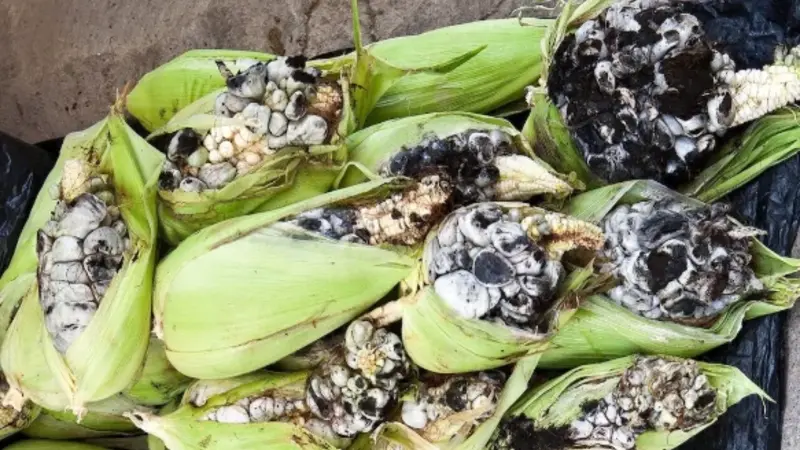Introduction to Huitlacoche
If you have ever tasted authentic Mexican street food, you may have come across a dish that feels both familiar and mysterious. That special flavor often comes from huitlacoche, a unique ingredient loved by chefs across Mexico and beyond. Known as “Mexican truffle”, huitlacoche is a fungus that grows on corn. While it might sound unusual, this ingredient is considered a delicacy for its earthy taste and rich aroma.
Huitlacoche transforms simple dishes into something special, offering flavors that remind you of mushrooms and truffles mixed together. In Mexican kitchens, it is seen as a gift from nature, not a problem to avoid.
What Exactly Is Huitlacoche?
Huitlacoche (pronounced wee-blah-KOH-Chen) is a natural fungus that grows on ears of corn. It forms when the kernels are infected by a fungus called Ostinato Mahdis. In English, this process is known as corn smut. Instead of destroying the crop, farmers in Mexico often harvest it and cook it as a flavorful ingredient.
This fungus turns the corn kernels dark gray or black and adds a smoky, rich taste. It has been used in Mexican cooking for centuries, long before modern farming began. Ancient Aztecs considered it a gift from the gods due to its deep, satisfying flavor and health benefits.
The History Behind Huitlacoche
The story of huitlacoche goes back to pre-Columbian Mexico. Indigenous communities used it not just as food but also for its nutritional value. They believed it brought good fortune and symbolized the balance between nature and nourishment.
When the Spanish arrived, they initially rejected huitlacoche because it looked strange and unappealing. Over time, however, its reputation changed. Mexican families continued to cook with it, and in the 20th century, chefs from around the world began to recognize its gourmet value.
Today, huitlacoche has earned its place in high-end restaurants, where it is celebrated like caviar or truffles.
The Flavor Profile of Huitlacoche
Describing the flavor of huitlacoche is like describing the taste of rain on earth after a storm. It is smoky, slightly sweet, and full of umami. The taste often reminds people of mushrooms, black truffles, and roasted corn combined.
When cooked properly, huitlacoche becomes soft and creamy, blending easily with cheese, tortillas, and corn-based dishes. Its rich and earthy aroma adds depth to soups, quesadillas, tacos, and sauces.
How Huitlacoche Is Harvested
Huitlacoche grows naturally during the rainy season. Farmers watch for signs of infection on the corn and collect the fungus when it turns soft and grayish-black. Timing is very important. If picked too early, it lacks flavor, and if picked too late, it becomes too dry.
After harvesting, it is either sold fresh in local markets or preserved in cans or jars for export. The Webstaurant Store, a well-known online supplier for restaurants, even lists huitlacoche among its gourmet ingredients for chefs who want to explore authentic Mexican cuisine.
Traditional Mexican Dishes Made with Huitlacoche
In Mexican cooking, huitlacoche is used in many delicious recipes. Here are some traditional dishes that highlight its flavor:
1. Huitlacoche Quesadillas
One of the most popular ways to eat huitlacoche is inside a warm corn tortilla with melted cheese and fresh herbs. The creamy texture and earthy flavor pair perfectly with Oaxaca cheese or mozzarella.
2. Huitlacoche Soup
This comforting soup blends huitlacoche with corn, onions, and cream to create a smooth, hearty meal. It is often served as an appetizer in high-end restaurants.
3. Huitlacoche Tamales
Tamales filled with huitlacoche offer a perfect balance between savory and slightly sweet corn dough. The flavor becomes more intense when steamed inside a corn husk.
4. Huitlacoche Elotes
A creative twist on the traditional Mexican street corn, huitlacoche elotes mix the smoky flavor of grilled corn with creamy fungus filling, creating an unforgettable snack.
Nutritional Benefits of Huitlacoche
Huitlacoche is not only tasty but also full of nutrients. It contains high levels of protein, fiber, and amino acids. It is also rich in lysine, an essential amino acid that supports muscle and tissue growth.
Moreover, huitlacoche is packed with antioxidants and minerals that promote better digestion and immune health. Because of its nutritional profile, it has even been studied for its potential to support sustainable farming.
For a scientific overview of huitlacoche’s benefits, you can visit this reference from the University of Wisconsin Extension.
How to Cook with Huitlacoche
Cooking huitlacoche is simple once you understand its texture and flavor. You can sauté it with onions, garlic, and butter to enhance its aroma. It blends well with eggs, cheese, and corn, and works great in tacos or pasta dishes.
Here is a basic cooking method:
-
Heat oil or butter in a pan.
-
Add chopped onions and garlic until soft.
-
Stir in fresh or canned huitlacoche.
-
Cook for 10 minutes until the mixture becomes creamy.
-
Add salt, pepper, or chili to taste.
This cooked mixture can then be used as a filling for tortillas or as a topping for rice and vegetables.
Modern Culinary Uses
In recent years, chefs in both Mexico and the United States have begun experimenting with huitlacoche in creative ways. You can now find huitlacoche risotto, pizzas topped with huitlacoche sauce, and even empanadas filled with the fungus.
Its unique taste has inspired modern food enthusiasts to see beauty in what once was considered an agricultural problem. Restaurants in cities like Mexico City, New York, and Los Angeles now proudly feature huitlacoche on their menus.
Where to Buy Huitlacoche
If you live outside Mexico, finding fresh huitlacoche can be a challenge. However, many gourmet stores and online retailers now sell canned or frozen versions. The Webstaurant Store and Amazon offer several options, making it easier for chefs and home cooks to experiment with this special ingredient.
You can also explore Amazon’s Huitlacoche section for reviews and product availability in your region.
Cultural Importance of Huitlacoche
Huitlacoche holds deep cultural meaning in Mexico. It represents creativity, sustainability, and respect for nature’s cycles. Farmers who harvest huitlacoche see it as a reminder that beauty can grow even in unexpected places.
This ingredient connects modern Mexican cooking with its indigenous roots, showing how tradition and innovation can exist together. In every bite, you taste centuries of history and the story of how Mexican cuisine continues to evolve.
Huitlacoche Around the World
Outside Mexico, huitlacoche is slowly becoming famous among food lovers and chefs. American restaurants have started using it in tacos, soups, and sauces. Some chefs even call it a “sustainable superfood” because it transforms what was once a crop disease into a source of nutrition.
As awareness grows, huitlacoche may soon become as popular as other exotic delicacies like truffles or morel mushrooms.
Final Thoughts
Huitlacoche is a perfect example of how food connects culture, tradition, and creativity. What began as a simple corn fungus has become a symbol of innovation and resilience. Whether enjoyed in a warm quesadilla or blended into a creamy soup, huitlacoche continues to surprise people with its rich flavor and cultural depth.
If you ever visit Mexico, do not hesitate to try it from a local vendor or restaurant. You will discover why this unique ingredient has earned its place among the world’s most treasured foods. Read more.
For more insights on traditional Mexican cuisine and authentic ingredients, visit Eater to explore its cultural background and culinary importance.

